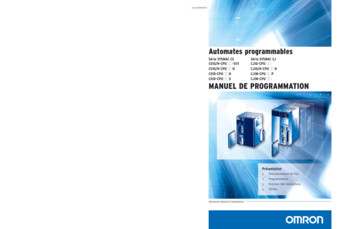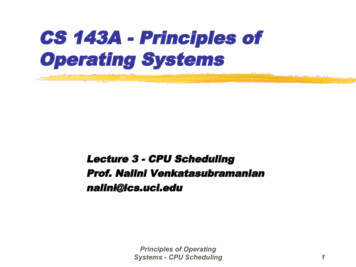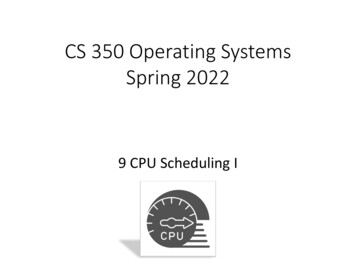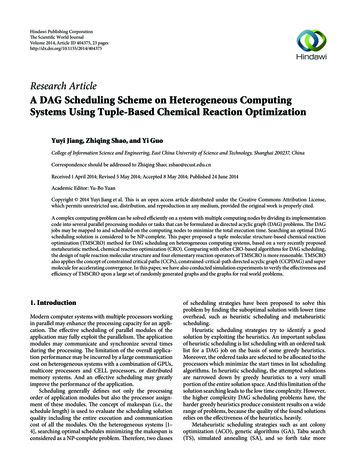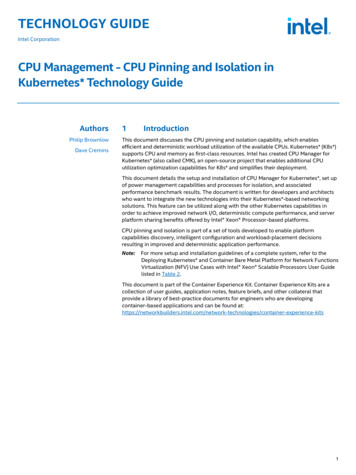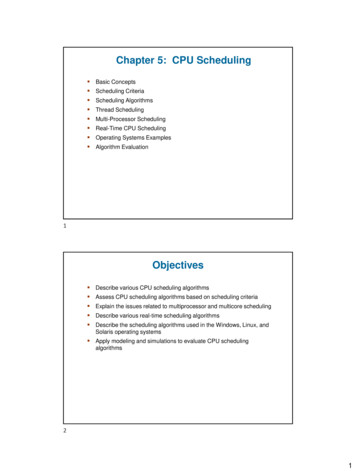
Transcription
Chapter 5: CPU Scheduling Basic ConceptsScheduling CriteriaScheduling AlgorithmsThread SchedulingMulti-Processor SchedulingReal-Time CPU SchedulingOperating Systems ExamplesAlgorithm Evaluation1Objectives Describe various CPU scheduling algorithmsAssess CPU scheduling algorithms based on scheduling criteriaExplain the issues related to multiprocessor and multicore schedulingDescribe various real-time scheduling algorithmsDescribe the scheduling algorithms used in the Windows, Linux, andSolaris operating systems Apply modeling and simulations to evaluate CPU schedulingalgorithms21
Basic Concepts Maximum CPU utilizationobtained with multiprogramming CPU–I/O Burst Cycle – Processexecution consists of a cycle ofCPU execution and I/O wait CPU burst followed by I/O burst CPU burst distribution is of mainconcern3Histogram of CPU-burst TimesLarge number of short burstsSmall number of longer bursts42
CPU Scheduler The CPU scheduler selects from among the processes in readyqueue, and allocates the a CPU core to one of them Queue may be ordered in various ways CPU scheduling decisions may take place when a process:1. Switches from running to waiting state2. Switches from running to ready state3. Switches from waiting to ready4. Terminates Scheduling under 1 and 4 is nonpreemptive All other scheduling is preemptive Consider access to shared data Consider preemption while in kernel mode Consider interrupts occurring during crucial OS activities5Dispatcher Dispatcher module gives control of the CPU tothe process selected by the short-termscheduler; this involves: switching context switching to user mode jumping to the proper location in the userprogram to restart that program Dispatch latency – time it takes for thedispatcher to stop one process and startanother running63
Scheduling Criteria CPU utilization – keep the CPU as busy as possible Throughput – # of processes that complete their execution pertime unit Turnaround time – amount of time to execute a particularprocess Waiting time – amount of time a process has been waiting in theready queue Response time – amount of time it takes from when a requestwas submitted until the first response is produced, not output (fortime-sharing environment)7Scheduling Algorithm Optimization Criteria Max CPU utilizationMax throughputMin turnaround timeMin waiting timeMin response time84
First- Come, First-Served (FCFS) SchedulingProcessP1Burst Time24P2P333 Suppose that the processes arrive in the order: P1 , P2 , P3The Gantt Chart for the schedule is:P1P2024P32730 Waiting time for P1 0; P2 24; P3 27 Average waiting time: (0 24 27)/3 179FCFS Scheduling (Cont.)Suppose that the processes arrive in the order:P2 , P3 , P1 The Gantt chart for the schedule is:P20 P33P1630Waiting time for P1 6; P2 0; P3 3Average waiting time: (6 0 3)/3 3Much better than previous caseConvoy effect - short process behind long process Consider one CPU-bound and many I/O-bound processes105
Shortest-Job-First (SJF) Scheduling Associate with each process the length of its next CPU burst Use these lengths to schedule the process with the shortest time SJF is optimal – gives minimum average waiting time for a given setof processes The difficulty is knowing the length of the next CPU request Could ask the user11Example of SJFProcessArrival TimeBurst TimeP10.06P22.08P34.07P45.03 SJF scheduling chartP40P13P39P21624 Average waiting time (3 16 9 0) / 4 7126
Determining Length of Next CPU Burst Can only estimate the length – should be similar to the previous one Then pick process with shortest predicted next CPU burst Can be done by using the length of previous CPU bursts, usingexponential averaging1. t n actual length of n th CPU burst2. n 1 predicted value for the next CPU burst3. , 0 14. Define : Commonly, α set to ½ Preemptive version called shortest-remaining-time-first13Prediction of the Length of the Next CPU Burst147
Examples of Exponential Averaging 0 n 1 n Recent history does not count 1 n 1 tn Only the actual last CPU burst counts If we expand the formula, we get: n 1 tn (1 - ) tn -1 (1 - )j tn -j (1 - )n 1 0 Since both and (1 - ) are less than or equal to 1, each successiveterm has less weight than its predecessor15Example of Shortest-remaining-time-first Now we add the concepts of varying arrival times and preemption tothe analysisProcessAarri Arrival TimeTBurst TimeP108P214P329P435 Preemptive SJF Gantt ChartP10P21P45P110P31726 Average waiting time [(10-1) (1-1) (17-2) (5-3)]/4 26/4 6.5 msec168
Round Robin (RR) Each process gets a small unit of CPU time (time quantum q), usually10-100 milliseconds. After this time has elapsed, the process ispreempted and added to the end of the ready queue. If there are n processes in the ready queue and the time quantum is q,then each process gets 1/n of the CPU time in chunks of at most q timeunits at once. No process waits more than (n-1)q time units. Timer interrupts every quantum to schedule next process Performance q large FIFO q small q must be large with respect to context switch, otherwiseoverhead is too high17Example of RR with Time Quantum 4ProcessP1Burst Time24P2P333 The Gantt chart is:P10P24P37P110P114P118P122P12630 Typically, higher average turnaround than SJF, but betterresponse q should be large compared to context switch time q usually 10ms to 100ms, context switch 10 usec189
Time Quantum and Context Switch Time19Turnaround Time Varies With The Time Quantum80% of CPU burstsshould be shorter than q2010
Priority Scheduling A priority number (integer) is associated with each process The CPU is allocated to the process with the highest priority (smallestinteger highest priority) Preemptive Nonpreemptive SJF is priority scheduling where priority is the inverse of predicted nextCPU burst time Problem Starvation – low priority processes may never execute Solution Aging – as time progresses increase the priority of theprocess21Example of Priority SchedulingProcessA arri Burst TimeTPriorityP1103P211P324P415P552 Priority scheduling Gantt Chart Average waiting time 8.2 msec2211
Priority Scheduling w/ Round-RobinProcessA arri Burst TimeTPriorityP143P252P382P471P533 Run the process with the highest priority. Processes with the samepriority run round-robin Gantt Chart wit 2 ms time quantum23Multilevel Queue With priority scheduling, have separate queues for each priority. Schedule the process in the highest-priority queue!2412
Multilevel Queue Prioritization based upon process type25Multilevel Feedback Queue A process can move between the various queues; aging can beimplemented this way Multilevel-feedback-queue scheduler defined by the followingparameters: number of queuesscheduling algorithms for each queuemethod used to determine when to upgrade a processmethod used to determine when to demote a processmethod used to determine which queue a process will enter whenthat process needs service2613
Example of Multilevel Feedback Queue Three queues: Q0 – RR with time quantum 8milliseconds Q1 – RR time quantum 16milliseconds Q2 – FCFS Scheduling A new job enters queue Q0 whichis served FCFS When it gains CPU, job receives 8milliseconds If it does not finish in 8milliseconds, job is moved toqueue Q1 At Q1 job is again served FCFSand receives 16 additionalmilliseconds If it still does not complete, it ispreempted and moved to queue Q227Thread Scheduling Distinction between user-level and kernel-level threads When threads supported, threads scheduled, not processes Many-to-one and many-to-many models, thread library schedulesuser-level threads to run on LWP Known as process-contention scope (PCS) since schedulingcompetition is within the process Typically done via priority set by programmer Kernel thread scheduled onto available CPU is system-contentionscope (SCS) – competition among all threads in system2814
Pthread Scheduling API allows specifying either PCS or SCS during thread creation PTHREAD SCOPE PROCESS schedules threads using PCSscheduling PTHREAD SCOPE SYSTEM schedules threads using SCSscheduling Can be limited by OS – Linux and macOS only allowPTHREAD SCOPE SYSTEM29Pthread Scheduling API#include pthread.h #include stdio.h #define NUM THREADS 5int main(int argc, char *argv[]) {int i, scope;pthread t tid[NUM THREADS];pthread attr t attr;/* get the default attributes */pthread attr init(&attr);/* first inquire on the current scope */if (pthread attr getscope(&attr, &scope) ! 0)fprintf(stderr, "Unable to get scheduling scope\n");else {if (scope PTHREAD SCOPE PROCESS)printf("PTHREAD SCOPE PROCESS");else if (scope PTHREAD SCOPE SYSTEM)printf("PTHREAD SCOPE SYSTEM");elsefprintf(stderr, "Illegal scope value.\n");}3015
Pthread Scheduling API/* set the scheduling algorithm to PCS or SCS */pthread attr setscope(&attr, PTHREAD SCOPE SYSTEM);/* create the threads */for (i 0; i NUM THREADS; i )pthread create(&tid[i],&attr,runner,NULL);/* now join on each thread */for (i 0; i NUM THREADS; i )pthread join(tid[i], NULL);}/* Each thread will begin control in this function */void *runner(void *param){/* do some work . */pthread exit(0);}31Multiple-Processor Scheduling CPU scheduling more complex when multiple CPUs are available Multiprocess may be any one of the following architectures: Multicore CPUs Multithreaded cores NUMA systems Heterogeneous multiprocessing3216
Multiple-Processor Scheduling Symmetric multiprocessing (SMP) is where each processor is selfscheduling. All threads may be in a common ready queue (a) Each processor may have its own private queue of threads (b)33Multicore Processors Recent trend to place multiple processor cores on same physical chip Faster and consumes less power Multiple threads per core also growing Takes advantage of memory stall to make progress on anotherthread while memory retrieve happens3417
Multithreaded Multicore SystemEach core has 1 hardware threads.If one thread has a memory stall, switch to another thread!35Multithreaded Multicore System Chip-multithreading (CMT)assigns each core multiplehardware threads. (Intel refersto this as hyperthreading.) On a quad-core system with 2hardware threads per core, theoperating system sees 8 logicalprocessors.3618
Multithreaded Multicore System Two levels of scheduling:1. The operating systemdeciding whichsoftware thread to runon a logical CPU2. How each coredecides whichhardware thread torun on the physicalcore.37Multiple-Processor Scheduling – Load Balancing If SMP, need to keep all CPUs loaded for efficiency Load balancing attempts to keep workload evenly distributed Push migration – periodic task checks load on each processor, and iffound pushes task from overloaded CPU to other CPUs Pull migration – idle processors pulls waiting task from busyprocessor3819
Multiple-Processor Scheduling – Processor Affinity When a thread has been running on one processor, the cache contentsof that processor stores the memory accesses by that thread. We refer to this as a thread having affinity for a processor (i.e.,“processor affinity”) Load balancing may affect processor affinity as a thread may be movedfrom one processor to another to balance loads, yet that thread losesthe contents of what it had in the cache of the processor it was movedoff of. Soft affinity – the operating system attempts to keep a thread runningon the same processor, but no guarantees. Hard affinity – allows a process to specify a set of processors it mayrun on.39NUMA and CPU SchedulingIf the operating system is NUMA-aware, it will assign memory closesto the CPU the thread is running on.4020
Real-Time CPU Scheduling Can present obvious challenges Soft real-time systems – Critical real-time tasks have the highestpriority, but no guarantee as to when tasks will be scheduled Hard real-time systems – task must be serviced by its deadline41Real-Time CPU Scheduling Event latency – the amount oftime that elapses from whenan event occurs to when it isserviced. Two types of latencies affectperformance1. Interrupt latency – timefrom arrival of interrupt tostart of routine thatservices interrupt2. Dispatch latency – timefor schedule to takecurrent process off CPUand switch to another4221
Interrupt Latency43Dispatch Latency Conflict phase ofdispatch latency:1. Preemption ofany processrunning in kernelmode2. Release by lowpriority processof resourcesneeded by highpriorityprocesses4422
Priority-based Scheduling For real-time scheduling, scheduler must support preemptive, prioritybased scheduling But only guarantees soft real-time For hard real-time must also provide ability to meet deadlines Processes have new characteristics: periodic ones require CPU atconstant intervals Has processing time t, deadline d, period p 0 t d p Rate of periodic task is 1/p45Rate Montonic Scheduling A priority is assigned based on the inverse of its period Shorter periods higher priority; Longer periods lower priority P1 is assigned a higher priority than P2.4623
Missed Deadlines with Rate Monotonic SchedulingProcess P2 misses finishing its deadline at time 8047Earliest Deadline First Scheduling (EDF) Priorities are assigned according to deadlines:the earlier the deadline, the higher the priority;the later the deadline, the lower the priority4824
Proportional Share Scheduling T shares are allocated among all processes in the system An application receives N shares where N T This ensures each application will receive N / T of the total processortime49POSIX Real-Time Scheduling The POSIX.1b standard API provides functions for managing real-time threads Defines two scheduling classes for real-time threads:1. SCHED FIFO - threads are scheduled using a FCFS strategy witha FIFO queue. There is no time-slicing for threads of equal priority2. SCHED RR - similar to SCHED FIFO except time-slicing occursfor threads of equal priority Defines two functions for getting and setting scheduling policy:1. pthread attr getsched policy(pthread attr t*attr, int *policy)2. pthread attr setsched policy(pthread attr t*attr, int policy)5025
POSIX Real-Time Scheduling API#include pthread.h #include stdio.h #define NUM THREADS 5int main(int argc, char *argv[]){int i, policy;pthread t tid[NUM THREADS];pthread attr t attr;/* get the default attributes */pthread attr init(&attr);/* get the current scheduling policy */if (pthread attr getschedpolicy(&attr, &policy) ! 0)fprintf(stderr, "Unable to get policy.\n");else {if (policy SCHED OTHER) printf("SCHED OTHER\n");else if (policy SCHED RR) printf("SCHED RR\n");else if (policy SCHED FIFO) printf("SCHED FIFO\n");}51POSIX Real-Time Scheduling API (Cont.)/* set the scheduling policy - FIFO, RR, or OTHER */if (pthread attr setschedpolicy(&attr, SCHED FIFO) ! 0)fprintf(stderr, "Unable to set policy.\n");/* create the threads */for (i 0; i NUM THREADS; i )pthread create(&tid[i],&attr,runner,NULL);/* now join on each thread */for (i 0; i NUM THREADS; i )pthread join(tid[i], NULL);}/* Each thread will begin control in this function */void *runner(void *param){/* do some work . */pthread exit(0);}5226
Operating System Examples Linux scheduling Windows scheduling Solaris scheduling53Linux Scheduling Through Version 2.5 Prior to kernel version 2.5, ran variation of standard UNIX schedulingalgorithm Version 2.5 moved to constant order O(1) scheduling time Preemptive, priority based Two priority ranges: time-sharing and real-time Real-time range from 0 to 99 and nice value from 100 to 140 Map into global priority with numerically lower values indicating higher priorityHigher priority gets larger qTask run-able as long as time left in time slice (active)If no time left (expired), not run-able until all other tasks use their slicesAll run-able tasks tracked in per-CPU runqueue data structure Two priority arrays (active, expired) Tasks indexed by priority When no more active, arrays are exchangedWorked well, but poor response times for interactive processes5427
Linux Scheduling in Version 2.6.23 Completely Fair Scheduler (CFS)Scheduling classes Each has specific priority Scheduler picks highest priority task in highest scheduling class Rather than quantum based on fixed time allotments, based on proportion ofCPU time 2 scheduling classes included, others can be added1. default2. real-timeQuantum calculated based on nice value from -20 to 19 Lower value is higher priority Calculates target latency – interval of time during which task should run atleast once Target latency can increase if say number of active tasks increasesCFS scheduler maintains per task virtual run time in variable vruntime Associated with decay factor based on priority of task – lower priority ishigher decay rate Normal default priority yields virtual run time actual run time To decide next task to run, scheduler picks task with lowest virtual run time55CFS Performance5628
Linux Scheduling (Cont.) Real-time scheduling according to POSIX.1b Real-time tasks have static priorities Real-time plus normal map into global priority scheme Nice value of -20 maps to global priority 100 Nice value of 19 maps to priority 13957Linux Scheduling (Cont.) Linux supports load balancing, but is also NUMA-aware. Scheduling domain is a set of CPU cores that can be balancedagainst one another. Domains are organized by what they share (i.e., cache memory.) Goalis to keep threads from migrating between domains.5829
Windows Scheduling Windows uses priority-based preemptive scheduling Real-time threads can preempt non-real-timeHighest-priority thread runs nextDispatcher is schedulerThread runs until (1) blocks, (2) uses time slice, (3) preempted byhigher-priority thread32-level priority schemeVariable class is 1-15, real-time class is 16-31Priority 0 is memory-management threadQueue for each priorityIf no run-able thread, runs idle thread59Windows Priority Classes Win32 API identifies several priority classes to which a process canbelong REALTIME PRIORITY CLASS, HIGH PRIORITY CLASS,ABOVE NORMAL PRIORITY CLASS,NORMAL PRIORITY CLASS, BELOW NORMAL PRIORITY CLASS,IDLE PRIORITY CLASS All are variable except REALTIME A thread within a given priority class has a relative priority TIME CRITICAL, HIGHEST, ABOVE NORMAL, NORMAL,BELOW NORMAL, LOWEST, IDLE Priority class and relative priority combine to give numeric priority Base priority is NORMAL within the class If quantum expires, priority lowered, but never below base6030
Windows Priority Classes (Cont.) If wait occurs, priority boosted depending on what was waited for Foreground window given 3x priority boost Windows 7 added user-mode scheduling (UMS) Applications create and manage threads independent of kernel For large number of threads, much more efficient UMS schedulers come from programming language libraries likeC Concurrent Runtime (ConcRT) framework61Windows Priorities6231
Solaris Priority-based scheduling Six classes available Time sharing (default) (TS) Interactive (IA) Real time (RT) System (SYS) Fair Share (FSS) Fixed priority (FP) Given thread can be in one class at a time Each class has its own scheduling algorithm Time sharing is multi-level feedback queue Loadable table configurable by sysadmin63Solaris Dispatch Table6432
Solaris Scheduling65Solaris Scheduling (Cont.) Scheduler converts class-specific priorities into a per-thread globalpriority Thread with highest priority runs next Runs until (1) blocks, (2) uses time slice, (3) preempted byhigher-priority thread Multiple threads at same priority selected via RR6633
Algorithm Evaluation How to select CPU-scheduling algorithm for an OS? Determine criteria, then evaluate algorithms Deterministic modeling Type of analytic evaluation Takes a particular predetermined workload and defines theperformance of each algorithm for that workload Consider 5 processes arriving at time 0:67Deterministic Evaluation For each algorithm, calculate minimum average waiting time Simple and fast, but requires exact numbers for input, applies only tothose inputs FCS is 28ms: Non-preemptive SFJ is 13ms: RR is 23ms:6834
Queueing Models Describes the arrival of processes, and CPU and I/O burstsprobabilistically Commonly exponential, and described by mean Computes average throughput, utilization, waiting time, etc Computer system described as network of servers, each with queueof waiting processes Knowing arrival rates and service rates Computes utilization, average queue length, average wait time,etc69Little’s Formula n average queue lengthW average waiting time in queueλ average arrival rate into queueLittle’s law – in steady state, processes leaving queue must equalprocesses arriving, thus:n λxW Valid for any scheduling algorithm and arrival distribution For example, if on average 7 processes arrive per second, andnormally 14 processes in queue, then average wait time perprocess 2 seconds7035
Simulations Queueing models limited Simulations more accurate Programmed model of computer system Clock is a variable Gather statistics indicating algorithm performance Data to drive simulation gathered via Random number generator according to probabilities Distributions defined mathematically or empirically Trace tapes record sequences of real events in real systems71Evaluation of CPU Schedulers by Simulation7236
Implementation Even simulations have limited accuracyJust implement new scheduler and test in real systems High cost, high riskEnvironments varyMost flexible schedulers can be modified per-site or per-systemOr APIs to modify prioritiesBut again environments vary7337
2 5 2 P 3 8 2 P 4 7 1 P 5 3 3 Run the process with the highest priority. Processes with the same priority run round-robin Gantt Chart wit 2 ms time quantum Multilevel Queue With priority scheduling, have separate queues for each priority. Schedule the process in the highest-priority queue! 23 24
